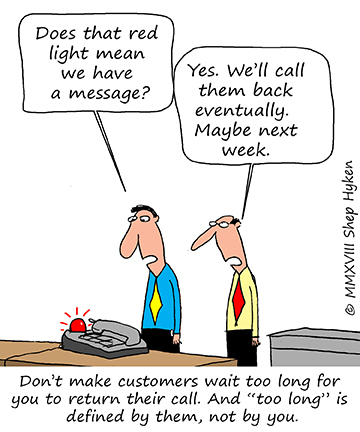Shep Hyken's Blog, page 154
January 26, 2018
Guest Blog: Why You Should Train Frontline Personnel to Be Great Listeners
This week we feature an article by Evan Hackel who writes about why it is important to train your frontline with excellent listening skills. Pay attention to what customers are saying. Take advantage of what you are seeing and hearing and then use what you’ve learned to surprise your customers with amazing and exceptional customer service. – Shep Hyken
I have had negative experiences when dealing with frontline staff, and I am sure you have too. Just two weeks ago I went to check in at a condo-hotel where a good friend of mine was lending me his unit. It was 1:00 AM Mountain time and 3:00 AM on the East Coast were my friend lived. The front desk attendant could not find my reservation anywhere and was clearly upset that I had woken her from her nap. She seemed to be fumbling around and very frustrated. After a half hour, I ended up having to call my friend at 3:30 AM. The issue was that the attendant was looking for the reservation under my name, not my friend’s name. I had told her my friend’s name, but she wasn’t listening and in my opinion, she didn’t care.
That happened because a frontline employee was not listening
And then have been times when I enjoyed superb service from frontline staff. A waiter remembering my favorite meal. A phone call from my favorite ski shop telling me about a new pair of skis that they knew would be perfect for me. The simple use of my name.
Those experiences have something in common too . . .
They happened because a frontline employee was a good listener
Great Service Is All about Listening . . .
There are many explanations for why front-line people don’t listen. They’re multitasking . . . another worker called in sick . . . they’re nervous because it’s their first day on the job. But those are nothing more than excuses, and if you have learned to live with them in your organization, you are doing great damage to your business.
You Can Train People to Listen . . .
You have heard the common advice that people can be trained to avoid interruptive listening – which means that while people are speaking to them, they should not already be formulating a response in their minds. That’s good advice, and following it can improve listening.
Yet there are other listening skills that should be part of your training for frontline staff.
Ingaged listening – Employees can learn to concentrate on listening for the most important “nuggets” in what customers are saying. Are customers asking for a problem to be corrected, for a special service, for a special health concern to be addressed, or for something else?
Compartmentalizing – Your front-line people, like all workers, are handling multiple tasks at the same time. Yet you can train them to think in only one “compartment” at a time. If your retail salespeople are completing a retail sale on the floor of your store, for example, they can learn to concentrate on that task alone and ignore ringing phones, restocking the shelves, serving other customers and other tasks that are in other compartments.
Observing – Train employees to observe and notice something about each customer they encounter. Is he or she well dressed, polite, hurried, or something else? Employees who take a moment to observe something about each customer listen better to them.
Connecting on a personal level – Front-line employees can be trained to start each interaction by asking a question like, “Where did you travel from to see us?” or simply, “How are you doing today?” Connecting in that way is more than a pleasantry, it establishes a level of communication where better listening happens.
Repeating back – Repeating back to customers what they have just said only takes a moment, and it helps assure that the information that your employee received is the same as what the customer was trying to send. One good technique is for your frontline staffers to say, “Let me be sure I understood” and then to restate in their own words the customer’s question or concern.
Asking for confirmation – A simple statement like, “Have I provided what you are asking for?” can elevate the level of communication and assure that feel they have been heard, respected . . . and well served.
What’s the Best Way to Teach Listening Skills in Training?
The first step is to explain that listening isn’t a “nice to have” skill, but one of the most important that employees should learn.
Work simulations offer a great way to teach the listening skills I recommend in this article. Have some trainees take the roles of customers and others take the roles of front-line staffers. Practicing real-world customer interactions in this way makes sure that great listening skills will “stick,” be used – and elevate the quality of the customer experience your company delivers.
 Evan Hackel, the creator of Ingaged Leadership, is an expert consultant in the areas of training, leadership, and franchising. Evan is CEO of Tortal Training, a leading training development company in Charlotte, North Carolina, and Principal and Founder of Ingage Consulting, a consulting firm in Woburn, Massachusetts. To learn more about Evan’s book Ingaging Leadership, visit Ingage.net. Follow @ehackel.
Evan Hackel, the creator of Ingaged Leadership, is an expert consultant in the areas of training, leadership, and franchising. Evan is CEO of Tortal Training, a leading training development company in Charlotte, North Carolina, and Principal and Founder of Ingage Consulting, a consulting firm in Woburn, Massachusetts. To learn more about Evan’s book Ingaging Leadership, visit Ingage.net. Follow @ehackel.
For more articles from Shep Hyken and his guest contributors go to customerserviceblog.com.
Read Shep’s latest Forbes Article: CES Showcases Robots (Again) And Demonstrates How They Can Provide Amazing Customer Service
The post Guest Blog: Why You Should Train Frontline Personnel to Be Great Listeners appeared first on Shep Hyken.
January 24, 2018
The Power of the Last and Lasting Impression
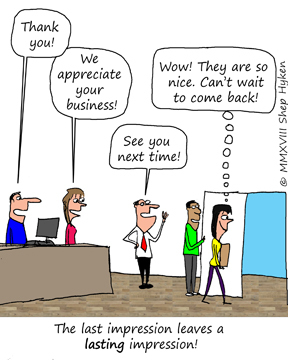 People say all the time that the first impression is important. No doubt it is. Just as important, if not even more so, is the last impression, as it leaves a lasting impression.
People say all the time that the first impression is important. No doubt it is. Just as important, if not even more so, is the last impression, as it leaves a lasting impression.
If you’ve been following my work, this concept may be familiar to you. Recently, I tweeted about lasting impressions (follow me on Twitter @Hyken if you aren’t already doing so). I received a response from Nayeli Burns (@Nayelihrc), the concierge at Encore Event Technologies, an “in-house” event production company in hotels and resorts throughout North America. If you’ve ever been to a hotel for a conference, they are the people who set up the audio/visual support, the staging, lighting, rigging, and more.
Nayeli shared that Encore has a relentless focus on customer service, and part of their customer experience includes a “departure meeting” where they can personally thank clients and get feedback on the event they helped produce. But, there is more to it than just saying “thank you” and asking how they did. The meeting is orchestrated between the concierge (yes, Encore has a concierge in each of the venues they support), the sales manager, and the director of events. The meeting is meant to create a memorable last impression for their client. Prior to the “departure meeting”, the director of event technologies is briefed on some of the highlights of the client’s conference, which are brought up during the discussion. The personalized nature of the meeting is important, as it reminds the client of the great service they received and that they made the right choice to do business with Encore. In Nayeli’s words, “Our clients love this.”
This “departure meeting” works for a number of reasons:
It is a great way to say, “Thank you!” to a customer. And, all customers deserve to be shown appreciation.
It is an opportunity to receive face-to-face and eye-to-eye feedback. Getting your customer’s feedback in a timely fashion is vital, so why not do it just as the event is coming to an end?
It’s personalized. This is a crucial point. Encore’s director of event technologies gets briefed before the meeting to learn about what happened at the event and uses that as part of the conversation.
Recapping the event reminds the client how Encore helped make the meeting a success. It reinforces why they should hold their meeting at a venue that Encore supports.
Finally, the meeting serves the purpose of leaving a powerful last impression, which is, as mentioned, a lasting impression.
What I like about what Encore Event Technologies has done, is that they have made the last impression a formal part of the client’s journey. It isn’t a “thank you” in passing. It’s a sit-down meeting, which is a central part of the process. The “departure meeting” is a major touch-point in a long process that helps ensure that the client will want to come back.
Shep Hyken is a customer service expert, keynote speaker, and New York Times bestselling business author. For information, contact 314-692-2200 or www.hyken.com. For information on The Customer Focus customer service training programs, go to www.thecustomerfocus.com. Follow on Twitter: @Hyken
customer service training programs, go to www.thecustomerfocus.com. Follow on Twitter: @Hyken
(Copyright © MMXVIII, Shep Hyken)
The post The Power of the Last and Lasting Impression appeared first on Shep Hyken.
January 23, 2018
Amazing Business Radio: Jeff Day

When Virtual Reality Becomes Your Customer’s Reality
Shep Hyken Interviews Jeff Day, CEO of Bluewater Technologies
What if you could be face-to-face with your customers, anytime, anywhere?
<span data-mce-type=”bookmark” style=”display: inline-block; width: 0px; overflow: hidden; line-height: 0;” class=”mce_SELRES_start”></span><span style=”display: inline-block; width: 0px; overflow: hidden; line-height: 0;” data-mce-type=”bookmark” class=”mce_SELRES_start”></span><span data-mce-type=”bookmark” class=”mce_SELRES_start”></span><span data-mce-type=”bookmark” class=”mce_SELRES_start”></span>&amp;lt;span data-mce-type=”bookmark” style=”display: inline-block; width: 0px; overflow: hidden; line-height: 0;” class=”mce_SELRES_start”&amp;gt;&amp;lt;/span&amp;gt;
Shep Hyken sits down with Jeff Day, discussing virtual reality and how companies are using this technology to better serve their customers.
Top Takeaways:
Virtual reality uses a headset to have multi-projected environments of a space create the realistic sensation of physically being somewhere. It’s being somewhere without actually being there.
Augmented reality projects in a physical space items that are not physically there. This uses more camera and sensory technology.
Google created Google Cardboard, a small headset device made out of cardboard that turns your mobile phone into a virtual reality headset. In 2016, 88 million units were sold.
The Kindle Fire Mayday Button allows you to instantly have a person pop up on your screen and be there to guide you through your problem. It’s not a recording. It’s a real live person in a call center speaking directly to you, on your device, helping you out.
Microsoft HoloLens allows you to take and pin virtual display monitors in the air so that they don’t occupy any physical space. When the glasses are worn, the images hover in the air in front of you and allow you to manipulate and move the images.
People want to see and experience something before they buy it. Think about what your customers would like to see, in virtual reality or augmented reality, and ask yourself if you can bring that experience to life virtually for them.
About:
Jeff Day is the CEO of Bluewater Technologies, a Detroit-based technology company that specializes in experiential marketing and events. Jeff and his company want to help enterprising brands better tell their stories.
Shep Hyken is a customer service and experience expert, “New York Times” best-selling author, award-winning keynote speaker, and your host of Amazing Business Radio.
“If you aren’t already down the path of thinking about how to amplify the experience with customers, utilizing virtual reality, you’re going to be left in the dust.” – Jeff Day
This episode of Amazing Business Radio with Shep Hyken answers the following questions … and more:
What can I do to create an amazing experience for my customers before they even have my product in their hands?
How can I use virtual reality in my business?
How can technology help improve the customer experience (CX)?
The post Amazing Business Radio: Jeff Day appeared first on Shep Hyken.
January 22, 2018
5 Top Customer Service Articles For the Week of January 22, 2018
Each week I read a number of customer service and customer experience articles from various resources. Here are my top five picks from last week. I have added my comment about each article and would like to hear what you think too.
10 Customer Experience Mistakes You Need to Avoid in 2018 by Ronak Meghani
(CustomerThink) Here are 10 basic, however viable courses for business to turn irate, baffled, or disappointed clients into upbeat clients.
My Comment: We start off this week’s Top Five roundup with an article that reminds us often of the more common mistakes that could be made by any company in any type of industry. By knowing not what to do, we’ll know exactly what to do.
How Customer Service Can Turn Angry Customers into Loyal Ones by Wayne Huang, John Mitchell, Carmel Dibner, Andrea Ruttenberg, and Audrey Tripp
(Harvard Business Review) Customer service seems like common sense for businesses. But how valuable is it really?
My Comment: This is a fascinating article with a focus on customer service delivered through social channels. The authors started by surveying 400,000 customers who interacted with brands in the airline and wireless industries to find out how much more customers would spend if they received better service. What drives a positive experience is applicable to any industry.
What an Amazon mistake and a burning car taught me about Customer Experience Planning by Ricardo Saltz Gulko
(CustomerThink) I call this “The 22 Commandments” of dealing with mistakes and crises in UX, CX, design, and more.
My Comment: Here is a tale of two brands that promises a hassle-free “No Questions Asked” return policy. You’ll learn the right and wrong way to handle a problem. I love when a good story teaches a valuable lesson.
Incorporating a chatbot? How to put the customer first by Jay Baer
(MarTech) bots can cut costs, but columnist Jay Baer says before you jump on the chat bandwagon, you need to make sure you’re putting the customer first
My Comment: This article is written by Jay Baer, one of the smartest customer service and experience experts in the industry. If your company currently uses chatbots, or is thinking about implementing a chatbot solution, then you must read this article. The focus, as it always should be in customer service, is to put the customer first.
Easy Things You Can Do to Improve Customer Experience by Olga Kolodynska
(LiveChat) There are numerous of situations outside of work when customer service leads the prime. And I can’t help but notice when it’s done right or not. If it’s a “no” I immediately have a subject for another blog post. For me, real life examples are the best place for inspiration. So let me guide you through my latest customer experiences. I hope you’ll learn from them.
My Comment: This article has some wisdom on what companies are doing right when it comes to customer experience, but just as important (if not more so) is what they are doing wrong. For example, regarding feedback, I’m surprised at how some companies (and people) fight feedback with excuses rather than embrace it with appreciation.
BONUS
The Expectation Economy by Trendwatching
(Trendwatching) Even though you’ve heard about the New Economy, the Experience Economy, the Surprise Economy, the Attention Economy, the Leisure Economy and so on, we can’t help but throw yet another Economy your way: the EXPECTATION ECONOMY. Capturing the essence of 2008’s demanding consumer arena, it is—surprise, surprise—all about those pesky, demanding consumers.
My Comment: Here’s a reprint of an article that came out ten years ago -and it is just as relevant today as it was back then. It focuses on the “Expectation Economy.” Consider that today your competition could be anyone – even outside of your industry. And, just copying competitors is a “race to the bottom.”
Shep Hyken is a customer service expert, professional speaker and New York Times bestselling business author. For information on The Customer Focus customer service training programs go to www.thecustomerfocus.com. Follow on Twitter: @Hyken
customer service training programs go to www.thecustomerfocus.com. Follow on Twitter: @Hyken
The post 5 Top Customer Service Articles For the Week of January 22, 2018 appeared first on Shep Hyken.
January 19, 2018
Guest Blog: Parcel Lockers – A Retailer’s Secret Weapon
This week we feature an article by Gaven Rolfe who writes about parcel lockers and how they can offer benefits for retailers. I really like anything that can offer convenience for our customers. – Shep Hyken
Parcel Lockers: A Retailer’s Secret Weapon
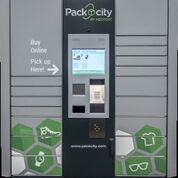
When you think of parcel lockers you probably think of lockers found at apartment buildings and condominiums. Even Amazon has launched parcel lockers into the residential industry. But this innovative, final-mile delivery method can also be a secret weapon for retailers.
From lower shipping costs to a better customer experience, parcel lockers can offer big benefits for retailers.
Delivery and Returns
Retail parcel lockers are different from the manual, low-tech residential parcel lockers you often see today. They are a convenient and easy click-and-collect delivery solution. As soon as an order is delivered and placed into a parcel locker, the customer receives a notification via email or SMS message with a one-time PIN code or QR code. The customer then goes to the parcel locker station and enters or scans the code. The parcel locker door opens and the customer retrieves the order. This provides a complete chain of custody and added security for retailers.
This delivery method can also offer an easy return process. Customers simply drop off their returns at a parcel locker station rather than mailing through a carrier or standing in line at the service desk, two tasks many customers hate. Instead, they place the return label on their parcel, scan the label at the parcel locker station and place the parcel in the locker door that opens. Retailers can then process the returned orders at a convenient time for them.
Enhancing the Customer Experience
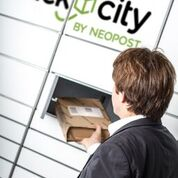
Parcel lockers greatly enhance the customer experience by offering a convenient 24/7 delivery option. By placing these weather-resistant parcel lockers outside of a brick and mortar store, retailers can achieve instant customer satisfaction. But these systems can also be placed inside a store to not only offer an additional delivery method but to also increase in-store traffic as customers walk through the store to see what’s new.
For retailers, this final-mile delivery solution can save both time and money. Instead of shipping hundreds or thousands of small orders to individual residences, retailers can use their own transportation to ship bulk orders to the brick and mortar store for placement into the parcel lockers. This lowers shipping costs while providing flexibility for customer service staff.
While your customer reviews will confirm the success of this innovative delivery method, there’s one more benefit: many retail parcel lockers also offer robust reporting capabilities. You’ll be able to receive reports and metrics on a number of key performance indicators, including occupancy, turnover, pickup times, parcel size and more. This allows you to determine the parcel locker station’s return on investment as well as the need for additional parcel locker stations on site.
So, when it comes to providing a unique customer experience, parcel lockers can be a win-win for all.
Gaven Rolfe is the Western Regional Territory Manager of Packcity Intelligent Parcel Lockers and ProShip, Inc. , a Neopost company and global provider of logistics software and product solutions. P roShip’s powerful solutions enable goods to be delivered faster, more efficiently and more cost-effectively than ever before. For more information, please visit www.proshipinc.com .
For more articles from Shep Hyken and his guest contributors go to customerserviceblog.com.
Read Shep’s latest Forbes Article: Is Your Customer Support Killing Your Business?
The post Guest Blog: Parcel Lockers – A Retailer’s Secret Weapon appeared first on Shep Hyken.
January 17, 2018
The 25 Dollar Mistake
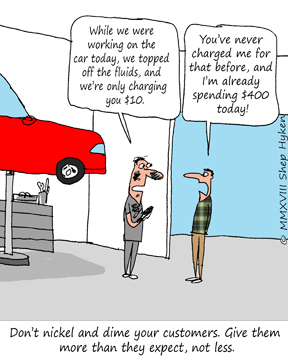 I recently planned a small two-day meeting for about 25 people. This was the second year for this meeting. The previous year we had stayed at a hotel that did a magnificent job of taking care of us. After that meeting, I talked to our sales rep and mentioned that if they repeated the contract we signed for that first year, we would most likely come back. And, we did.
I recently planned a small two-day meeting for about 25 people. This was the second year for this meeting. The previous year we had stayed at a hotel that did a magnificent job of taking care of us. After that meeting, I talked to our sales rep and mentioned that if they repeated the contract we signed for that first year, we would most likely come back. And, we did.
In looking over the final contract for our most recent meeting at the hotel, there were a few minor changes from the year prior. Most of those were due to slight increases in the room rate and food costs. I expected that this might happen, and so I was fine with those. However, there was one change in the agreement that was unacceptable. The first year, the hotel gave us free Internet service for our attendees. This year they wanted to charge us for it.
Asking for free Internet is a common negotiation. So, the hotel chose to go into negotiation mode on this point. They came back and said they would only charge $75 for everyone to have Internet access in the meeting room. That is reasonable, except I made it clear that I wanted the identical terms as the year before. Our sales rep said she would go back to her leadership team and ask them to honor last year’s contract terms. She came back and said they reduced the cost to us to $25.
Well, $25 wasn’t a deal-breaker, and staying at that hotel was definitely easier than starting over with another hotel. But I had to wonder, who on the leadership team was so short-sighted as to charge $25 for something they could simply give away? We were getting ready to book about 35 rooms in a slow week for the hotel and spend thousands of dollars in their restaurants, bar, and for our banquet meals. I asked to speak to the individual on the “leadership team” who was making this short-sighted decision. I never heard from that person.
When I arrived on the property for the meeting, my very nice salesperson met with me. She again apologized for the small Internet fee. It really wasn’t her fault, but I still wanted to get the explanation from the person who made the decision. I candidly told her that a little “nickel and dime” charge of $25 might have me looking at other hotels in the area for next year’s meeting. It wasn’t just the $25. That’s not worth switching hotels over. It was the idea that we had originally agreed to repeating last year’s contract, and that tiny charge was the only thing getting in the way of them honoring our verbal agreement.
The lesson here is that it’s not about the money. It didn’t break the bank for us to pay the $25 fee. The hotel violated several rules of customer service. They didn’t recognize the long-term value of their customer, and they were willing to lose him over a very small fee that, by the way, they had waived in the past. They changed the rules in the middle of the game when they didn’t honor their agreement of “same as last year,” even though it was just $25. And, with all they were charging, they “nickel and dimed” their customer. In their eyes, they could only see the money they were earning rather than all the money they could potentially lose when we decided to go elsewhere the next year.
Shep Hyken is a customer service expert, keynote speaker, and New York Times bestselling business author. For information, contact 314-692-2200 or www.hyken.com. For information on The Customer Focus customer service training programs, go to www.thecustomerfocus.com. Follow on Twitter: @Hyken
customer service training programs, go to www.thecustomerfocus.com. Follow on Twitter: @Hyken
(Copyright © MMXVIII, Shep Hyken)
The post The 25 Dollar Mistake appeared first on Shep Hyken.
January 16, 2018
Amazing Business Radio: Chris Smoje
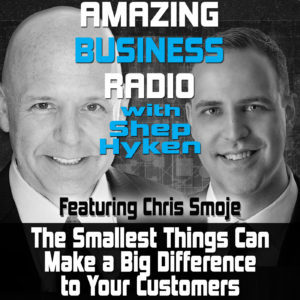
The Smallest Things Can Make the Biggest Difference to Your Customers
Shep Hyken Interviews Chris Smoje, Founder of DIME Customer Service
What can you be doing to make a big difference for your customers?
<span style=”display: inline-block; width: 0px; overflow: hidden; line-height: 0;” data-mce-type=”bookmark” class=”mce_SELRES_start”></span><span data-mce-type=”bookmark” class=”mce_SELRES_start”></span><span data-mce-type=”bookmark” class=”mce_SELRES_start”></span>&lt;span data-mce-type=”bookmark” style=”display: inline-block; width: 0px; overflow: hidden; line-height: 0;” class=”mce_SELRES_start”&gt;&lt;/span&gt;
Shep Hyken and Chris Smoje discuss how the smallest actions can make the greatest impact on your customers.
Top Takeaways:
The DIME Customer Service approach: Deliberate Interactions Memorable Experiences
Four stages of service: You can’t have one without the other. They must all go together, like steps or levels.
Habitual – This goes hand-in-hand with being deliberate. Great service must be practiced all the time, and it will become habit. Great service doesn’t happen by accident. It is intentional.
Enjoyable – Giving customer service is like giving a gift. Doing it should bring joy. It creates a positive emotion, and the gift giver expects nothing in return.
Remarkable – To get customers’ attention, something remarkable must happen. This doesn’t have to be something big; it just needs to stand out.
Transformational – There is so much more to a sale than just making a sale. In some way or another, each interaction with a customer leads to some kind of change in their life. It goes so much deeper than just what is seen on the surface.
The five values of a service-focused team: AEIOU
Accountable – Every member of the team must be on the same page, and must be held accountable.
Energetic – In front of customers, there’s a particular way you must behave. Staff members need to bring energy into each interaction.
Innovative – You don’t have to have a lot of resources, or a huge staff to give great customer service. Empower the people you do have so the leadership can focus on the tasks they need to get done.
Optimistic – When an organization knows what it’s doing, there is clarity and purpose. It’s important to internalize and really understand what works best for you. Since customer service is a long-term game, evolution is always happening. In order to get through this, optimism is critical.
Unique – Leaders must be connected to their customers. This allows the leaders to understand that each customer is unique. In turn, the customers can be served better.
About:
Chris Smoje is the founder of DIME Customer Service where he works with organizations to achieve service excellence through their culture, interactions, processes, and experiences. He is a regular media commentator on customer service in Australia.
Shep Hyken is a customer service and experience expert, “New York Times” best-selling author, award-winning keynote speaker, and your host of Amazing Business Radio.
“Customer service doesn’t happen overnight. It should always be evolving.” – Chris Smoje
This episode of Amazing Business Radio with Shep Hyken answers the following questions … and more:
How can I be more intentional with my customers?
How can I deliver better customer service?
How can great customer service become a habit?
How can I get to know my customers better?
The post Amazing Business Radio: Chris Smoje appeared first on Shep Hyken.
January 15, 2018
5 Top Customer Service Articles For the Week of January 15, 2018
Each week I read a number of customer service and customer experience articles from various resources. Here are my top five picks from last week. I have added my comment about each article and would like to hear what you think too.
A Greater Purpose Will Give Your Customer And Employee Experience An Extra Edge by Adrian Swinscoe
(Forbes) Historically, customers used to buy the practical benefits of a product or service. More recently, however, the experience that customers receive has become ever more important and the battleground on which most companies are now competing.
My Comment: I’ve always felt that a company’s “giving back” campaign (as in giving back to the community or philanthropic efforts) are part of the customer experience. Some customers feel good about the companies they do business with when they know they are contributing to, as the author of this article calls it, a greater purpose. And, more than just feeling good, some customers make the choice because of the company’s contributions. Richard Branson’s Virgin Unite has won the hearts (and dollars) of tens of thousands of customers because they like being a part of that “bigger cause.” This article points out the importance of making philanthropy a part of the customer experience.
Making Customer Experience Your Marketing and Sales Magnet by Chuck Sykes
(CustomerThink) The takeover is complete: The customer is in control and customer experience now reigns supreme over the business universe.
My Comment: A few years ago people were saying, “Customer service is the new marketing.” Today it’s not the “new marketing.” It’s is marketing. The author of this short article makes three important points to emphasize that customer service, marketing and sales have merged to create an experience that helps customers make buying decisions, and at the same time, makes them feel good about those decisions.
The One Question That Saved This Company From Losing My Business by Kostya Kimlat
(Kostya Kimlat) I was trying to get electronic payments out to my partners and vendors before the end of the year. What should have been an easy process turned into a nightmare.
My Comment: I just love a good story that makes an important point – and in this case, it’s a point about customer service. He was walking out of his bank, ready to do business elsewhere, when an employee asked a powerful question. It was a true human-to-human interaction. It made him want to come back. This line sums it up nicely: No matter how great your brand may be, the reputation and customer loyalty is determined by the final exchange between employee and customer.
101 Reasons Why You Need To Embrace Live Chat by Megan
(Websitebuilder) You are undoubtedly aware of the importance of customer service on your online business’ road to success. But, what you may not know is that customers’ expectations have now reached new heights, demanding instant support and fast acting. In order to keep up with the latest trends, it is essential to improve customer experience. If you cannot think of an innovative way to do so – we have the answer.
My Comment: This short article and infographic was sent to me earlier this week. 101 reasons for live chat is a lot of reasons, and some are more compelling than others. Regardless, there’s some interesting stats and facts that confirm that customers like using this simple technology. Depending on your business, if you’re not already using live chat, it’s time to think about it.
Top 10 Tips to Design a Perfect Customer Experience Survey by Adi Bhat
(QuestionPro) Organizations have long emphasized on customer experience and the value it adds to the organization. Right from purchasing a product to the after sales interaction can be broadly termed as customer experience.
My Comment: One of the most common discussions we have with our clients is around how to develop a powerful customer service or experience survey. This short article has some of the basics that should be considered as you create the perfect survey that will give you the insights you need to deliver a better customer experience.
BONUS
5 SIMPLE TIPS to MASSIVELY increase survey RESPONSE RATE by Kushal Dev
(Customer Guru) If you are getting low responses on your surveys your customers are pretty much thinking the same. A low response rate only means low stickiness.
My Comment: Following up on the fifth article in this roundup (about creating surveys), it seemed appropriate to add this article as a “Top Five Bonus.” Our friends at Customer Guru, the NPS experts, wrote a short article about how to increase response rates to your surveys. Great info!
Shep Hyken is a customer service expert, professional speaker and New York Times bestselling business author. For information on The Customer Focus customer service training programs go to www.thecustomerfocus.com. Follow on Twitter: @Hyken
customer service training programs go to www.thecustomerfocus.com. Follow on Twitter: @Hyken
The post 5 Top Customer Service Articles For the Week of January 15, 2018 appeared first on Shep Hyken.
January 12, 2018
Guest Blog: Customer Service Role … Avoid these Myths on Customer Service
This week we feature an article by Mike Schoultz who shares his top 20 list of myths on customer experience not to tell yourself or things you should never say to a customer. This is a great list and one you should pay attention too. – Shep Hyken
The problem is never how to get new ideas into your mind, but how to eliminate the old ideas. Customer service designs that are remarkable get talked about. And getting talked about in this light is a great thing, right? No question. So telling yourself these myths about customer experience is a big no-no and won’t take you where you want to go will they?
Check out our thoughts on customer focus.
We often get questions and comments on delivering great customer service and experiences. From clients and customers commenting on our blog. Many relate to customer service actions that are reminders of what we already know (but we occasionally forget). These are big enablers of customer service and experience. They usually won’t create Wow service on their own, but their absence is noted by customers and lowers excellent customer service to just good enough or less.
Related: How Marriott Courtyard Turned Customer Failure into Service Recovery
Much of how we help people deliver better customer experience and service is with examples. These are fun and useful because we all have them (since we’re all customers.) And sometimes it helps to look at examples of things we shouldn’t say to customers. That is if we want them to keep coming back.
So, here is my top 20 list of myths on customer experience not to tell yourself or things you should never say to a customer that we often use in client workshops:
Following a script
Because scripts and checklists are all the rage now, employees are scripted to death. Many feels (and some are told) they are not there to think but to follow the script. And often that’s exactly what they do, even when it makes no sense and wastes the customer’s time.
When I hear a script, I wonder if the person can help me. Not a confidence builder, is it? If you have a script or checklist, pay attention to the real world too. Your customers will thank you.
Not my error
Never pass the buck or blame someone else, especially if they’re part of your company. You don’t look any better or smarter by doing so. But you certainly appear uninterested in solving the customer’s problem. Your time is better spent fixing and helping rather than blaming and finger-pointing.
Employees don’t care
If you hire people that are not delighted to be social and servicing people, you’ll likely end up with employees that don’t care. Nothing is worse for a customer’s experience.
Limited employee expertise
Putting new employees on the firing line with no or limited training results in employees who have to hand customers off or plead no knowledge. Both are equally bad. Employees that are not motivated to learn rapidly are also a bad situation waiting to happen.
Limited employee authority
No empowerment for employees to do the right things? You might as well build a robot to respond to customers. Nothing worse than having an employee that knows what needs to be done, but is not empowered to do it.
No consistency
As we stated in the introduction, you need to have all good and delighted customer experiences. Satisfactory and bad experiences will negate all the delighted customers talk about, simply because negative results usually get talked about more. Need a lot of focus on consistency of the good and delighted experiences.
No interest in customer feedback
Many customers are itching to tell you how to improve. If they are not given an opportunity, it degrades the experience. Likewise, customers always feel good when they see positive improvements.
No personalized engagement
Employees who rarely smile and engage socially at one on one engagement are at a very serious disadvantage in being able to create a delightful customer experience. In the longer term, a business needs to build relationships, particularly with its best customers. Hard to do with no personalized engagement.
Pushy sales techniques
All selling should be off limits in any situation. Hard selling is a definite no-no for any good customer experience. Very little turns off customers much faster than pushy sales techniques.
Poor listeners
Two-way conversations begin with employees listening carefully before responding. Being stuck on transmit mode in a two-way conversation won’t go anywhere fast.
Poor follow through
If a customer is told X will be done, they should feel that it will happen. Hopefully faster and better than promised. If something unexpected happens, a good experience demands the customer be notified and kept informed.
Don’t meet expectations
If promises are not kept, expectations by the customer not achieved, negative experiences result. Too negative and your business will lose the customer forever. The absolute last thing you want.
Saying you are sorry
I am sorry you feel that way. People often say this as an apology. But it’s not. Because it again shifts the blame to the customer.
If you’re sorry, then say so. Don’t qualify it. When customers hear an apology like this, they understand what you’re doing. You’re saying, “I know I’m supposed to apologize but I don’t want to.”
Related: Crash Course on How to Apologize to a Customer
A better option is just to say “I’m sorry this happened” or simply “I’m sorry.
It tells the customer you are sorry for the situation the customer is in without making you responsible for it.
Just calm down
Is there ever a situation where this has the intended effect? Not that we can see. It seems like you are tossing gasoline on the fire.
More like they’ll get even angrier while they tell YOU to calm down. They’ll escalate the matter, and they’ll probably become a former customer.
Listen, let them vent, have them talk to someone else if they want. But never tell them to calm down.
Recording: Your call is very important to us
I hear this so often I ignore it. And that is how it should be. A recorded message is not the place to tell your customers how much you value their business. Do it with a real, live, caring human being. That’s a message your customers will believe (and respond to).
You made a mistake
We all know customers make mistakes. Everyone makes mistakes. But when you point it out directly and blatantly, you risk offending or embarrassing your customer. How would you like it? No blaming is needed. Instead, focus on helping them understand the right way to do things so that they won’t make a mistake again.
Talk to the corporate office
If a customer has feedback, a request or a complaint, they don’t care who YOU have to forward it to. They don’t care that another person in your organization will deal with it. What they want is for YOU to take the initiative to get the ball rolling. It’s not the customer’s job to go trying to find the exact person who should handle their situation. That’s YOUR job.
It’s our company policy
With too many employees this is just an easy way to get out of doing something they’d rather not do.
If you want to help then find a way. Don’t hide behind a company policy. And if you can’t work around the policy, offer an alternative or escalate the matter to the customer. If your customers see you are trying to help, they’ll be less disappointed even if they don’t get exactly what they want.
Please take a number
If I were the customer in this situation, “huh?” is the only response I’d be able to muster, assuming I didn’t just walk out. But it happens. People get so focused on policies, procedures, systems, and rules that they forget about a little tool called “common sense.”
No one else has complained
This one always amazes me. Are we taking a survey? Are we voting on the situation? If enough other customers have a problem, then you’ll listen to me (or handle my problem)? Is that really how you want to be perceived?
Of course not, that’s ridiculous. But I’ve heard employees (and managers) say this all too often. The problem is they are focusing on their perspective. They should be focusing on the customer and helping solve a problem.
The bottom line
Remember one simple thing here: all employees need to view themselves as customer advocates, period. Customer service actions that are remarkable get talked about. And getting talked about in this light is a great thing, right? No question.
Do you have a lesson about making your customer experience better you can share with this community? Have any questions or comments to add to the section below?
Mike Schoultz is a digital marketing and customer service expert. With 48 years of business experience, he consults on and writes about topics to help improve the performance of small business. Find him on G+ , Facebook , Twitter , and LinkedIn .
For more articles from Shep Hyken and his guest contributors go to customerserviceblog.com.
Read Shep’s latest Forbes Article: Leadership Lesson: It Comes From The Heart
The post Guest Blog: Customer Service Role … Avoid these Myths on Customer Service appeared first on Shep Hyken.
January 10, 2018
When Can I Expect Your Call?
Sometimes, the most common-sense customer service tips are the most important.
A while back, I was talking to my lawyer about the “client service” I experience from him and his firm. It was evident that he was truly interested in my feedback. My response was simple. “I just have one complaint. I wish you would respond quicker to my phone calls and emails.”
Many times, he would take several days to respond – to both my phone calls and my emails. For what I was paying him, I felt that he should be giving me a better level of service. Well, it turns out that I wasn’t the only one who felt that way. Upon surveying clients of law firms, one of the common complaints is a slow response.
It wasn’t long after that chat with my lawyer that I was hired to speak at a large law firm’s partner retreat. There were almost 500 lawyers in attendance. The client at the firm who hired me asked me to go over my content for the speech. One of the areas I emphasized was a quick response, specifically to phone calls. He asked me to take that section out. His explanation was that it was too basic and would potentially cause the audience to lose interest over information that was so rudimentary.
The speaker who spoke just before me happened to be their number-one client, who worked at a company in Washington, D.C. that did millions of dollars each year in business with the firm. He talked about how great the law firm was, and then he opened it up for questions. The first question from one of the attorneys in the audience was, “Can you tell us something that we could do to make your experience better?”
Without hesitation, the client said, “Return my phone calls faster.”
I glanced over at my client and he had a petrified look on his face. He looked at me and whispered, “Maybe you should put the part about a quick response to phone calls and emails back into the speech.” I smiled and gave him the “thumbs up.”
Here was a law firm that charged hundreds of dollars per hour for their work. Their clients were willing to pay this, adding up to millions of dollars per year. And, the first thought that came to mind when asked how to improve the experience was basic common-sense: just return calls quicker.
I can’t emphasize this simple concept enough. Customers want to know that you are focused on them. Taking three days to call someone back shows a lack of focus, if not a lack of concern, for the customer – whether it’s true or not.
So, there’s nothing fancy to teach for today’s customer service lesson. Nothing technical or difficult. Nothing that really takes practice or role-playing. It’s just a simple common-sense tactic that shows you are paying attention to your customer, and that’s just to call them back in a reasonable timeframe. Not three days. Not two days. But ideally, the same day. Maybe even within a few hours, if you’re available.
Shep Hyken is a customer service expert, keynote speaker, and New York Times bestselling business author. For information, contact 314-692-2200 or www.hyken.com. For information on The Customer Focus customer service training programs, go to www.thecustomerfocus.com. Follow on Twitter: @Hyken
customer service training programs, go to www.thecustomerfocus.com. Follow on Twitter: @Hyken
(Copyright © MMXVIII, Shep Hyken)
The post When Can I Expect Your Call? appeared first on Shep Hyken.






